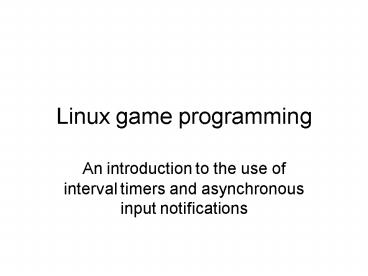Linux game programming - PowerPoint PPT Presentation
Title:
Linux game programming
Description:
Linux game programming. An introduction to the ... Our prior animation demo ... of 'smooth' and 'flicker-free' animation, by synchronizing drawing-operations ... – PowerPoint PPT presentation
Number of Views:48
Avg rating:3.0/5.0
Title: Linux game programming
1
Linux game programming
- An introduction to the use of interval timers and
asynchronous input notifications
2
Our prior animation demo
- We achieved the illusion of smooth and
flicker-free animation, by synchronizing
drawing-operations with Vertical Retrace - But more is needed in a game thats fun
- Some deficiencies in our animate1 demo
- Ball movements tied to Vertical Retrace
- The viewer lacked any real-time control
- How can we overcome these limitations?
3
Decoupling move from draw
- Our program-loop had used logic like this
- do
- vsync() // delay until start of the next
retrace - hide_ball() // erase the ball
- move_ball() // adjust its location
- show_ball() // redraw the ball
- --count // decrement a counter
- while ( count gt 0 )
4
Linux provides interval timers
- include ltsys/time.hgt
- struct itimerval itval, itold
- itval.it_value.tv_sec 2
- itval.it_value.tv_usec 0
- itval.it_interval.tv_sec 0
- itval.it_interval.tv_usec 10000
- setitimer( ITIMER_REAL, itval, itold )
- (See the man page for additional details)
5
SIGALRM
- When timer expires our application gets
notified, by being sent a signal from Linux - Normally an application gets terminated if the
SIGALRM signal is delivered to it - But we can alter that default behavior, by
installing a signal-handler that we design - We can move-the-ball when SIGALRM is received,
regardless of Vertical Retrace
6
Our signal-handler
- void on_alarm( int signum )
- // modify these global variables
- ball_xcoordinate xincrement
- ball_ycoordinate yincrement
- // The signal() function installs our handler
- signal( SIGALRM, on_alarm)
7
Main program-loop revised
- We can now omit ball-movement in main loop
- do
- vsync() // delay until start of the next
retrace - hide_ball() // erase the old ball
- oldx newx oldy newy // remember new
position - show_ball() // redraw the new ball
- --count // decrement a counter
- while ( count gt 0 )
- Ball-movement is managed by signal-handler
8
Giving the user control
- Linux supports asynchronous terminal i/o
- We can reprogram the terminal console so a SIGIO
signal will be sent to our program whenever the
user decides to press a key - And we can install a signal-handler of our own
design that executes if SIGIO arrives - This will allow a user to control our game
9
Noncanonical terminal i/o
- We already learned how to reprogram the terminal
to allow raw keyboard input - include lttermios.hgt
- struct termios tty
- tcgetattr( 0, tty ) // get tty settings
- tty.c_lflag ( ICANON ECHO ISIG )
- tty.c_cc VMIN 1 tty.c_cc VTIME 0
- tcsetattr( 0, TCSAFLUSH, tty ) // install
10
Handling a key-press
- Heres a simple signal-handler that lets a user
decide to terminate our program (by hitting the
ltESCAPEgt-key) instead of the program itself
deciding to quit when a counter reaches zero - void on_input( int signum )
- int inch 0
- read( 0, inch, 4 )
- if ( inch ESCAPE_KEY ) done 1
11
Enabling asynchronous I/O
- Now we need to install our signal-handler,
specify which program will receive SIGIO, then
enable the delivery of these signals - signal( SIGIO, on_input )
- fcntl( 0, F_SETOWN, getpid() )
- int flagval fcntl( 0, F_GETFL, NULL )
- flagval O_ASYNC // turn on flag-bit
- fcntl( 0, F_SETFL, flagval )
12
Program-loop revised again
- done 0
- do
- oldx xloc, oldy yloc // remember
- draw_ball() // use current location
- vsync() // await next retrace
- hide_ball() // erase previous ball
- while ( !done )
- // xloc, yloc, and done get changed by
handlers
13
Enhancment more user-control
- In pong game the user moves a paddle
- The paddle can only be moved left or right
- Lower wall of the playing-court is removed
- Ball will escape unless it hits the paddle
- Keyboard has left and right arrow keys
- Our input signal-handler could move the paddle
whenever a user hits an arrow-key
14
In-class exercise 1
- Before you remove the game-courts lower wall,
see if you can implement the paddle-movements
(left or right) in response to a users hitting
the left-arrow or right-arrow - You will need to investigate the numerical
code-sequence that Linux generates when a user
hits one of these arrow-keys - Our rawtty.cpp application may be useful!
15
In-class exercise 2
- For brevity, our animate2 demo-program removed
the capability of users controlling the speed of
the ball-movements (with an argument supplied on
the command-line) - Can you devise a way for users to exert
real-time control over the balls speed by
pressing keys while the program is running (for
example, the key and the - key)?

